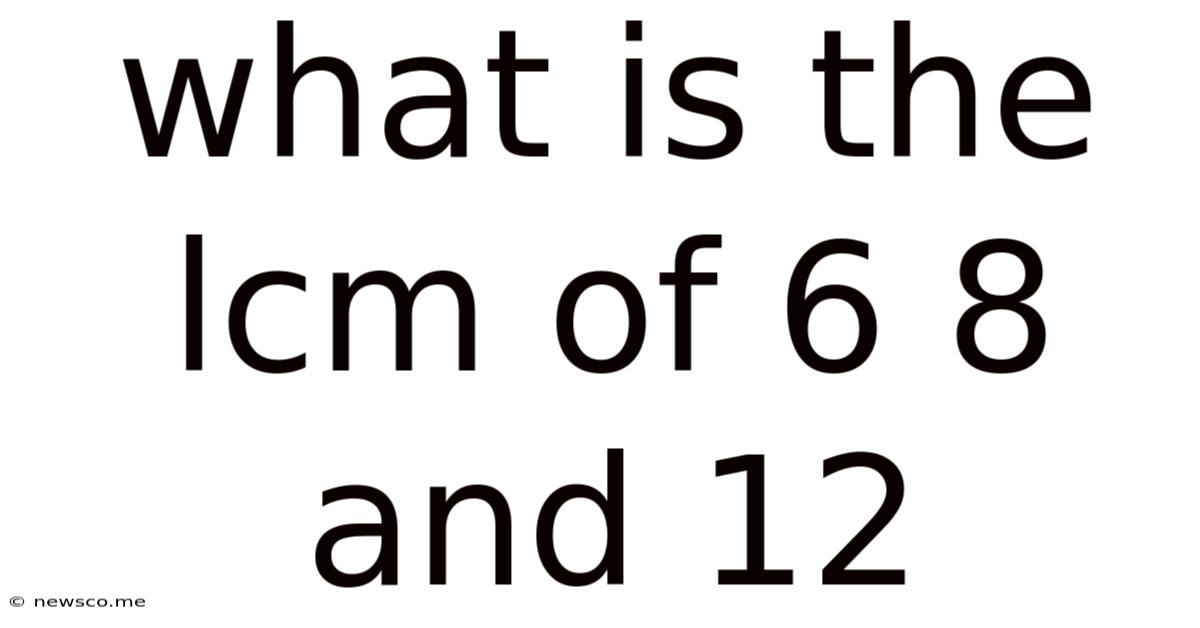What Is The Lcm Of 6 8 And 12
News Co
Apr 23, 2025 · 5 min read

Table of Contents
What is the LCM of 6, 8, and 12? A Deep Dive into Least Common Multiples
Finding the least common multiple (LCM) of a set of numbers is a fundamental concept in mathematics with widespread applications in various fields, from scheduling problems to simplifying fractions. This comprehensive guide will delve into the process of determining the LCM of 6, 8, and 12, exploring multiple methods and highlighting the underlying principles. We'll also examine the broader significance of LCMs and their practical uses.
Understanding Least Common Multiples (LCM)
Before we tackle the specific problem of finding the LCM of 6, 8, and 12, let's solidify our understanding of what an LCM actually is. The least common multiple of two or more integers is the smallest positive integer that is divisible by all the integers. In simpler terms, it's the smallest number that all the given numbers can divide into evenly without leaving a remainder.
For example, consider the numbers 2 and 3. Multiples of 2 are 2, 4, 6, 8, 10, 12... and multiples of 3 are 3, 6, 9, 12, 15... The smallest number that appears in both lists is 6. Therefore, the LCM of 2 and 3 is 6.
Methods for Finding the LCM
Several methods exist for calculating the LCM of a set of numbers. We'll explore three common approaches: listing multiples, prime factorization, and using the greatest common divisor (GCD).
1. Listing Multiples
This is the most straightforward method, particularly suitable for smaller numbers. We simply list the multiples of each number until we find the smallest multiple common to all.
- Multiples of 6: 6, 12, 18, 24, 30, 36, 42, 48, 54, 60...
- Multiples of 8: 8, 16, 24, 32, 40, 48, 56, 64, 72, 80...
- Multiples of 12: 12, 24, 36, 48, 60, 72, 84, 96, 108, 120...
By comparing the lists, we observe that the smallest multiple common to all three numbers is 24. Therefore, the LCM of 6, 8, and 12 is 24.
This method, while simple, can become cumbersome with larger numbers or a greater number of integers.
2. Prime Factorization
This method is more efficient for larger numbers. It involves finding the prime factorization of each number and then constructing the LCM from the prime factors.
- Prime factorization of 6: 2 x 3
- Prime factorization of 8: 2 x 2 x 2 = 2³
- Prime factorization of 12: 2 x 2 x 3 = 2² x 3
To find the LCM, we take the highest power of each prime factor present in the factorizations:
- The highest power of 2 is 2³ = 8
- The highest power of 3 is 3¹ = 3
Multiplying these highest powers together gives us the LCM: 8 x 3 = 24.
This method is generally more efficient and less prone to error than listing multiples, especially when dealing with larger numbers.
3. Using the Greatest Common Divisor (GCD)
The LCM and GCD of a set of numbers are closely related. We can use the GCD to calculate the LCM using the following formula:
LCM(a, b, c) = (a x b x c) / GCD(a, b, c)
First, we need to find the GCD of 6, 8, and 12. We can use the Euclidean algorithm for this:
- GCD(6, 8) = 2
- GCD(2, 12) = 2
Therefore, the GCD of 6, 8, and 12 is 2. Now, we can apply the formula:
LCM(6, 8, 12) = (6 x 8 x 12) / 2 = 576 / 2 = 24
This method is particularly useful when dealing with larger numbers where finding the prime factorization might be more challenging.
Applications of LCM
The concept of the least common multiple has significant practical applications across various domains:
1. Scheduling Problems
Imagine you have three different machines that perform a cycle of operation at intervals of 6, 8, and 12 hours, respectively. To find the time when all three machines will complete a cycle simultaneously, we need to find the LCM of 6, 8, and 12. The LCM, which we found to be 24, indicates that all three machines will complete a cycle at the same time after 24 hours.
2. Fraction Arithmetic
When adding or subtracting fractions with different denominators, we need to find a common denominator. The least common denominator is simply the LCM of the denominators. This ensures the simplest possible result.
3. Cyclic Events
LCMs are useful in scenarios involving cyclical events, such as planetary alignments, repeating patterns, or musical rhythms. Determining when these events will coincide requires finding the LCM of their respective cycles.
4. Modular Arithmetic and Cryptography
LCM plays a crucial role in modular arithmetic, which forms the basis of many modern cryptographic systems. The ability to find the LCM efficiently is essential for secure communication protocols.
Conclusion: The Importance of Understanding LCM
Finding the least common multiple of numbers might seem like a purely mathematical exercise, but its applications extend far beyond the classroom. From optimizing industrial processes to designing secure communication systems, the LCM is a fundamental concept with significant practical implications. Understanding the various methods for calculating the LCM, such as prime factorization and using the GCD, allows us to efficiently solve problems across diverse fields and strengthens our mathematical problem-solving skills. We have definitively shown that the LCM of 6, 8, and 12 is 24. Remember that mastering the concept of LCM opens doors to a deeper understanding of mathematical principles and their real-world applications.
Latest Posts
Related Post
Thank you for visiting our website which covers about What Is The Lcm Of 6 8 And 12 . We hope the information provided has been useful to you. Feel free to contact us if you have any questions or need further assistance. See you next time and don't miss to bookmark.